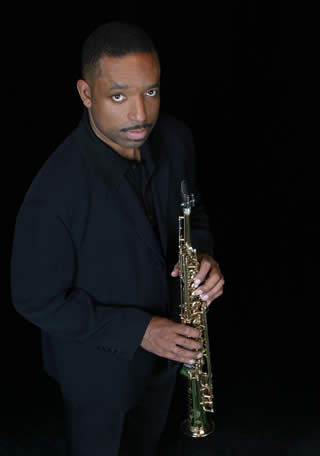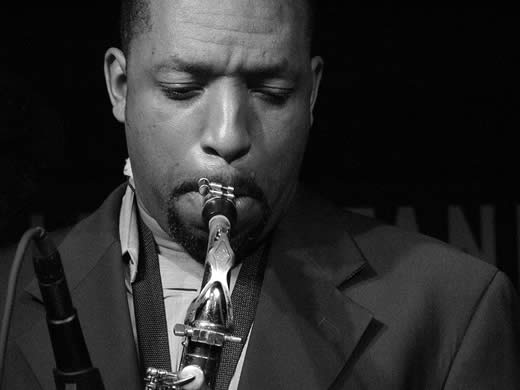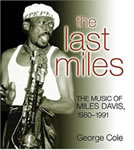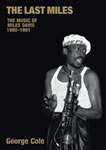Donald Harrison was one of the few alto saxophonists Miles had in his bands (others included Sonny Fortune, Kenny Garrett and Cannonball Adderley), when he played for a couple weeks in December 1986, sharing the saxophone chair with Bob Berg. Sadly, none of Donald’s performances are available officially, but a private recording of the first gig he did with Miles (in Syracuse, New York) reveals what a formidable player he is and how well he fitted in with Berg.
With typical bad timing, I only managed to track down Donald after my manuscript for The Last Miles had gone off to the printers, but here is an exclusive interview with Donald, who talks about his playing and his time with Miles.

Donald Harrison © Bennie. Photo courtesy of Donald Harrison
TheLastMiles.com: Donald, can you tell us a little about your background please?
Donald Harrison: I was born in New Orleans in June 1960. Before joining Miles, I played with Art Blakey and Terrence Blanchard. My inspirations were Charlie Parker, Miles, Louis Armstrong, John Coltrane – the guys who really followed their voices.
TLM: How did you get the miles gig?
DH: Somebody called me and told me to call me to call this number and Miles told me to come to his house. When I got there, he gave me some CDs to learn the music. Marcus Miller called me to the studio to do some track, but I don’t know what happened to it – it didn’t come out. [editors note: this is possibly a very early session for the album that became Amandla].
TLM: How did Miles direct you on-stage?
DH: He’d just point at you to play or hit you in the ribs with his elbow!
TLM: How did you and Bob Berg work together?
DH: For me, it was a case of ‘learn the music on your own.’ I didn’t have any rehearsals. My first gig was somewhere upstate New York.
TLM: What did you learn from playing with Miles?
DH: The greatest thing about that was what I learnt musically. How to focus at all times and how to try and find the premier sound.
TLM: What was Miles like as a person?
DH: He was a sweetheart to me. He was very supportive. At the time my focus was with a band I had with Terence Blanchard. When the band broke up, Miles hooked me up his manager and tried to get me a record deal with Warner Bros.
TLM: Why did you leave the band?
DH: I talked to Miles and I don’t know why it didn’t happen. At the time I told him the focus with the Harris and Blanchard group. At the time I really believed in electronic music and I had to play acoustic [saxophone] with him. I didn’t quit the band; it just didn’t happen. After that first night I think I learned what I needed to learn, so I didn’t care. He felt I was going to do something but I don’t think I was the right cat for that band. I loved the music Miles played, but felt that when you’re moving music forward, everybody has to know the whole scope. Miles knew it from bebop to rock ‘n’ roll to African. All the musicians had to have that depth to move on. They were all incredible musicians [in the band], but for me, that path and the energy I wanted around me wasn’t there. At the time, I don’t think everybody at the time had a knowledge of acoustic jazz. But after I left the band I still got phone calls from Miles. He was always asking what was happening in my life and was thinking about me.
TLM: Who were you closest to in the band?
DH: I liked Adam Holzman, Vince Wilburn and The Munch [Darryl Jones]. Those musicians are of the highest calibre and incredible people.
TLM: What was special about Miles?
DH: To me, he was really into people. He was fully aware of what was going on in the world of music. I learnt that to get it right, you have to have an understanding of people. Because whenever you study people, you write music that is informed from the times that you live in. That’s why he was always correct.
TLM: What did you do after Miles?
DH: I played with various people such as, Tony Williams and Terrence Blanchard – I was doing a lot of stuff. I’m also been finishing off a three-album project comprised of acoustic, hip-hop, and r&b/hip-hop music. A little bit of cross pollination.
TLM: Did you see Miles afterwards?
DH: I was once asked to open up for Miles in Spain. I remember going to the dressing room to say hello and he wouldn’t let us in the dressing room! And then they told us Miles didn’t want us to play! So we said, ‘okay’. We were packing up our gear and then they said ‘Miles wanted us to play.’ The next day we saw Miles at the airport. He said ‘Donald, what are you doing here?’ we said: ‘we opened for you last night! We tried to come and see you in the dressing and you wouldn’t let us in, and then you didn’t want us to play.’ He said ‘I wanted you to play. Why didn’t you come to the dressing room?’
TLM: Miles’s 1980s music was controversial. What’s your take on it?
DH: I think Miles’s greatest period was from the middle 50s to Wayne Shorter, Herbie and those guys. The sidemen that he chose had more focus and were more like him. I think he started hiring musicians who weren’t like him after that. They were great musicians in their own right, but they weren’t as well-versed in so many things as he was. I think he just wanted to get a different texture, a different feeling. All of his music is great. Some of the last records got played on smooth-jazz stations. He was happy and he must have achieved what he wanted to achieve. All that matters is that, if a musician plays music and one person likes it, then it’s valid. If it touches one person, it’s valid.
TLM: Some people were shocked by Miles recording hip-hop on his last album, Doo-Bop
DH: I wasn’t surprised. He could do what he wanted to do! A musician should have the right to do what they what. And if it touches you, you deal with it, and if it doesn’t, you move on. People heard some of the great CDs Miles did in the past and they wanted Miles to be that way all the time, but he couldn’t be like that – he had to move on.
Many thanks to Donald for sharing his memories of Miles and to Steven Sussman for the great shot of Donald. Check out Steven’s amazing portfolio of jazz photography at http://sussmanphotography.com/


